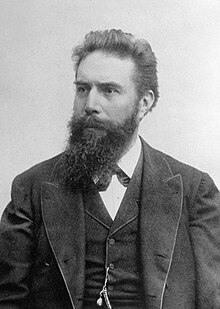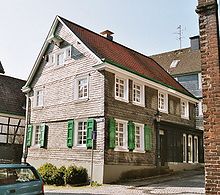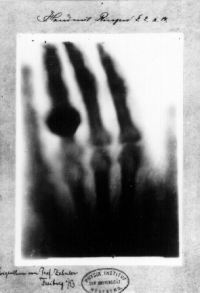 |
| Wilhelm Röntgen |
Today's Highlight in History:
1895 – While experimenting with electricity, Wilhelm Röntgen discovers the X-ray.
 |
| Birthplace of Roentgen in Remscheid-Lennep |
His Early Life and Education
Born on March 27, 1845 in the small town of Lennep (Rhine Province) in Germany; Wilhelm Conrad Roentgen was the only child of a cloth merchant. He was raised in the Netherlands because his family moved to Apeldoorn when he was still three. For his early education he went to a boarding school in Apeldoorn named, Institute of Martinus Herman van Doorn. He was not a sparkling student rather he was keenly interested in nature during his young years. In
1862, he joined Ambachts school; a technical school in Utrecht. There he got involved in a contrivance against one of his teachers and was expelled subsequently.
In 1865, he studied mechanical engineering at the Federal Polytechnic Institute in Zurich having failed to get admission in University of Utrecht lacking required credentials. There he flourished greatly under the influence of the teachers like Kundt and Clausius. He graduated from the University of Zurich and received his Ph.D. in 1869. In the same year, he assisted Kundt and followed him to Wurzburg and then to the University of Strasburg in 1873.
In 1865, he studied mechanical engineering at the Federal Polytechnic Institute in Zurich having failed to get admission in University of Utrecht lacking required credentials. There he flourished greatly under the influence of the teachers like Kundt and Clausius. He graduated from the University of Zurich and received his Ph.D. in 1869. In the same year, he assisted Kundt and followed him to Wurzburg and then to the University of Strasburg in 1873.
His Professional Career
In 1874 Röntgen became a lecturer at the University of Strassburg. In 1875 he became a professor at the Academy of Agriculture at Hohenheim, Württemberg. He returned to Strassburg as a professor of physics in 1876, and in 1879, he was appointed to the chair of physics at the University of Giessen. In 1888, he obtained the physics chair at the University of Würzburg, and in 1900 at theUniversity of Munich, by special request of the Bavarian government. Röntgen had family in Iowa in the United States and at one time planned to emigrate. Although he accepted an appointment at Columbia University in New York City and had actually purchased transatlantic tickets, the outbreak of World War I changed his plans and he remained in Munich for the rest of his career.
Discovery of X-ray Beams
On November 8, 1895, Wilhelm Röntgen stumbled on X-rays while experimenting with Lenard and Crookes tubes and began studying them. He found that if vacuum tube, used for experiments with cathode rays, was covered tightly with thin, black cardboard and placed in a darkened room, bright glow was observed during each discharge on a screen covered with fluorescent barium platinum cyanide (placed near the device). He realised that the fluorescence was caused by an agent which could infiltrate from within the vacuum tube through dark cardboard (impermeable to visible or ultraviolet radiation) to the outside of the set. He termed this agent as x-rays.
| Wilhelm Roentgen working in his laboratory |
Nearly two weeks after his discovery, he took the very first picture using X-rays of his wife Anna Bertha's hand. When she saw her skeleton she exclaimed "I have seen my death!".
 |
| Hand mit Ringen (Hand with Rings): print of Wilhelm Röntgen's first medical" X-ray, of his wife's hand, taken on 22 December 1895 |
He wrote an initial report "On a new kind of ray: A preliminary communication" and on December 28, 1895 submitted it to the Würzburg's Physical-Medical Society journal. It was the first written paper on X-rays. Röntgen referred to the radiation as "X", to indicate that it was an unknown type of radiation. The name stuck, although (over Röntgen's great objections) many of his colleagues suggested calling them Röntgen rays. They are still referred to as such in many languages, including German, Danish, Polish, Swedish, Finnish, Estonian, Russian, Japanese, Dutch,
In 1901 Röntgen was awarded the very first Nobel Prize in Physics. The award was officially "in recognition of the extraordinary services he has rendered by the discovery of the remarkable rays subsequently named after him".
| Nobel Prize |
Röntgen donated the monetary reward from his Nobel Prize to his university. Like Pierre Curie, Röntgen refused to take out patents related to his discovery, as he wanted mankind as a whole to benefit from practical applications of the same
Röntgen was married to Anna Bertha Ludwig (m. 1872, d. 1919) and had one child, Josephine Bertha Ludwig. With the inflation following World War I, Röntgen fell into bankruptcy later in life, spending his final years at his country home at Weilheim, near Munich.
In keeping with his will, all his personal and scientific correspondence was destroyed upon his death Röntgen died on 10 February 1923 from carcinoma of the intestine.It is not believed his carcinoma was a result of his work with ionizing radiation because of the brief time he spent on those investigations, and because he was one of the few pioneers in the field who used protective lead shields routinely.
World Events
1889 – Montana is admitted as the 41st U.S. state.
1892 – The New Orleans general strike begins, uniting black and white American trade unionists in a successful four-day general strike action for the first time.
1895 – While experimenting with electricity, Wilhelm Röntgen discovers the X-ray.
1898 – The Wilmington Insurrection of 1898, the only instance of an attempted coup d'état in American history.
1901 – Bloody clashes take place in Athens following the translation of the Gospels into demotic Greek.
1917 – The People's Commissars give authority to Vladimir Lenin, Leon Trotsky, and Joseph Stalin.
1933 – Great Depression: New Deal – US President Franklin D. Roosevelt unveils the Civil Works Administration, an organization designed to create jobs for more than 4 million unemployed.
1936 – Spanish Civil War: Francoist troops fail in their effort to capture Madrid, but begin the 3-year Siege of Madrid afterwards.
1957 – Operation Grapple X, Round C1: the United Kingdom conducts its first successful hydrogen bomb test over Kiritimati in the Pacific.
1960 – John F. Kennedy defeats Richard Nixon in one of the closest presidential elections of the twentieth century to become the 35th president of the United States.
1965 – The British Indian Ocean Territory is created, consisting of Chagos Archipelago, Aldabra, Farquhar and Des Roches islands.
1965 – The Murder (Abolition of Death Penalty) Act 1965 is given Royal Assent, formally abolishing the death penalty in the United Kingdom.
1966 – Former Massachusetts Attorney General Edward Brooke becomes the first African American elected to the United States Senate since Reconstruction.
1966 – U.S. President Lyndon B. Johnson signs into law an antitrust exemption allowing the National Football League to merge with the upstart American Football League.
1968 – The Vienna Convention on Road Traffic is signed to facilitate international road traffic and to increase road safety by standardising the uniform traffic rules among the signatories.
1972 – HBO launches its programming, with the broadcast of the 1971 movie Sometimes a Great Notion, starring Paul Newman and Henry Fonda.
1973 – The right ear of John Paul Getty III is delivered to a newspaper together with a ransom note, convincing his father to pay US$2.9 million.
2002 – Iraq disarmament crisis: UN Security Council Resolution 1441 – The United Nations Security Council unanimously approves a resolution on Iraq, forcing Saddam Hussein to disarm or face "serious consequences".
2004 – War in Iraq: More than 10,000 U.S. troops and a small number of Iraqi army units participate in a siege on the insurgent stronghold of Fallujah.
2011 – The potentially hazardous asteroid 2005 YU55 passes 0.85 lunar distances from Earth (about 324,600 kilometres or 201,700 miles), the closest known approach by an asteroid of its brightness since 2010 XC15 in 1976.
2013 – Typhoon Haiyan, one of the strongest storms in history hits the Visayas region in the Philippines. The typhoon killed 6,201 people as of 29 January 2014 and was considered the deadliest typhoon to hit the country. It caused around $1 billion in damages unofficially.
1892 – The New Orleans general strike begins, uniting black and white American trade unionists in a successful four-day general strike action for the first time.
1895 – While experimenting with electricity, Wilhelm Röntgen discovers the X-ray.
1898 – The Wilmington Insurrection of 1898, the only instance of an attempted coup d'état in American history.
1901 – Bloody clashes take place in Athens following the translation of the Gospels into demotic Greek.
1917 – The People's Commissars give authority to Vladimir Lenin, Leon Trotsky, and Joseph Stalin.
1933 – Great Depression: New Deal – US President Franklin D. Roosevelt unveils the Civil Works Administration, an organization designed to create jobs for more than 4 million unemployed.
1936 – Spanish Civil War: Francoist troops fail in their effort to capture Madrid, but begin the 3-year Siege of Madrid afterwards.
1957 – Operation Grapple X, Round C1: the United Kingdom conducts its first successful hydrogen bomb test over Kiritimati in the Pacific.
1960 – John F. Kennedy defeats Richard Nixon in one of the closest presidential elections of the twentieth century to become the 35th president of the United States.
1965 – The British Indian Ocean Territory is created, consisting of Chagos Archipelago, Aldabra, Farquhar and Des Roches islands.
1965 – The Murder (Abolition of Death Penalty) Act 1965 is given Royal Assent, formally abolishing the death penalty in the United Kingdom.
1966 – Former Massachusetts Attorney General Edward Brooke becomes the first African American elected to the United States Senate since Reconstruction.
1966 – U.S. President Lyndon B. Johnson signs into law an antitrust exemption allowing the National Football League to merge with the upstart American Football League.
1968 – The Vienna Convention on Road Traffic is signed to facilitate international road traffic and to increase road safety by standardising the uniform traffic rules among the signatories.
1972 – HBO launches its programming, with the broadcast of the 1971 movie Sometimes a Great Notion, starring Paul Newman and Henry Fonda.
1973 – The right ear of John Paul Getty III is delivered to a newspaper together with a ransom note, convincing his father to pay US$2.9 million.
2002 – Iraq disarmament crisis: UN Security Council Resolution 1441 – The United Nations Security Council unanimously approves a resolution on Iraq, forcing Saddam Hussein to disarm or face "serious consequences".
2004 – War in Iraq: More than 10,000 U.S. troops and a small number of Iraqi army units participate in a siege on the insurgent stronghold of Fallujah.
2011 – The potentially hazardous asteroid 2005 YU55 passes 0.85 lunar distances from Earth (about 324,600 kilometres or 201,700 miles), the closest known approach by an asteroid of its brightness since 2010 XC15 in 1976.
2013 – Typhoon Haiyan, one of the strongest storms in history hits the Visayas region in the Philippines. The typhoon killed 6,201 people as of 29 January 2014 and was considered the deadliest typhoon to hit the country. It caused around $1 billion in damages unofficially.


No comments:
Post a Comment